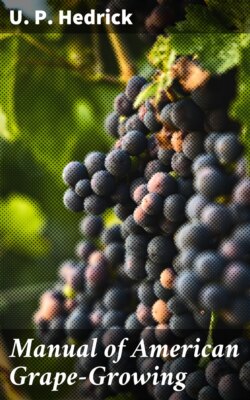Читать книгу Manual of American Grape-Growing - U. P. Hedrick - Страница 88
На сайте Литреса книга снята с продажи.
Drainage.
ОглавлениеThe ideal soil, as we are often told, resembles a sponge, and is capable of retaining the greatest possible amount of plant-food dissolved in water, and at the same time is permeable for air. This ideal, sponge-like condition is particularly desirable for the grape, especially native species, because the vines of all are exceedingly deep-rooted. Moreover, grapes thrive best in a warm soil. While, therefore, the roots may make good use of nutritious solutions, if not too diluted, in an undrained soil, they suffocate and do not receive sufficient bottom heat. It must be made emphatic that the grape will not thrive in water-logged land.
Unless the land is naturally well drained, under-drainage must be provided as the first step in the preparation of land for the vineyard. Tile-draining is usually best done by those who make land-draining their business, but information as to every requirement of land and detail of work may be secured from many texts, so that grape-growers may perform the work for themselves. In concluding the topic, the reader must be reminded that high and hill lands are not necessarily well drained, and low lands are not necessarily wet even if the surface is level. Often hilltops and hillsides need artificial draining; much less often valley lands and level lands may not need it. To assume, too, that gravelly and shaley soils are always well drained often leads directly contrary to the truth. Sandy and gravelly soils need drainage nearly as often as loamy and clayey ones.
Following tiling, if the land has had to be under-drained, the vineyard should be graded to fill depressions and to make the surface uniform. Usually this can be done with cutaway, tooth or some other harrow, but sometimes the grader or road-scraper must be put in use.
